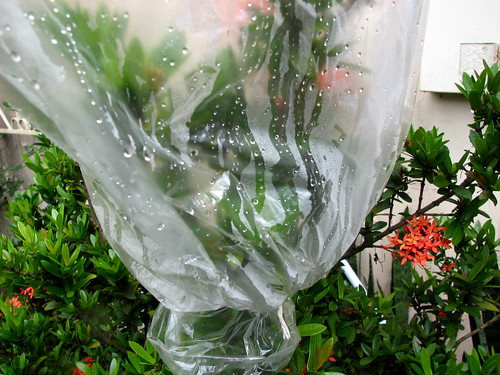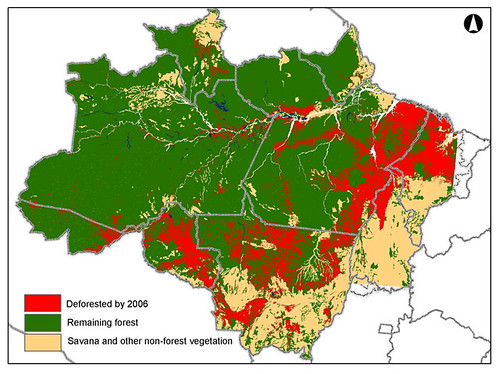THE ATLANTIC OCEAN AND GOING BACK

In a process called evapotranspiration, water vapor is released into the air by the vegetation of the Amazon forest which supplies about three-quarters of its own rainfall. In early April we tested for this process in front of our house in Rio Branco, the capital of Acre, Brazil's western-most Amazonian state. The water seen above arrives from the Atlantic Ocean 3,000 kilometers to the east and will begin its slow and meandering return only at the onset of the rainy season next October. It took only about two hours for the accumulation of condensed water shown above.
David Campbell tells the Amazon water-cycle story gloriously in his book, "A Land of Ghosts":
That's the poetry. Here is the science:
*****
UPDATE (05 August 2010):
Western Amazonia is facing another severe drought. With at least 2 more months of dry season here in Rio Branco the Acre River is already at a 30 year low. Our situation is undoubtedly impacted by the great "arc of deforestation" to the East.

Deforestation through 2006 in Brazilian Amazonia. (source: Ecology and Society)
There is now serious concern about what will happen as several stress factors combine into a feedback loop. The latest science on the Amazonian rain forests and drought has been published online in a special report from the New Phytologist which concludes that, although mass die-off is not inevitable, "... when expected feedbacks between vegetation and climate are combined with fire incidence and land-use change scenarios, we conclude that Amazon rain forests are highly vulnerable to loss during the coming decades."

In a process called evapotranspiration, water vapor is released into the air by the vegetation of the Amazon forest which supplies about three-quarters of its own rainfall. In early April we tested for this process in front of our house in Rio Branco, the capital of Acre, Brazil's western-most Amazonian state. The water seen above arrives from the Atlantic Ocean 3,000 kilometers to the east and will begin its slow and meandering return only at the onset of the rainy season next October. It took only about two hours for the accumulation of condensed water shown above.
David Campbell tells the Amazon water-cycle story gloriously in his book, "A Land of Ghosts":
The sky above the river is cloudless, but over the hot lands, the forest breathes vapor. The transpired water erupts into clouds of small consequence, save for the roving shade they cast over the canopy. In the dry season these clouds build up rapidly after dawn, becoming popcorn cumulus, then dissipate quickly in the late afternoon. Their energy is too centrifugal to create a column of strength, so the atmosphere’s stored energy dissipates, and the nights become star-clear. But today, near the onset of the rainy season, the air is nearly saturated, unable to hold much water. The clouds linger, sucking the breath from the land, and coalesce, eventually making the huge anviled nimbocumulus columns that puncture the cold stratosphere, creating the friction among the furious particles of air that are the forges of lightning.
Even though we are only about200600 kilometers from the Pacific Ocean, most of the air and clouds overhead originated on the other side of the continent in the Atlantic trade winds. During the journey from the Atlantic to the Andes, water vapor is repeatedly absorbed and recycled by the vegetation. In fact, the typical Amazon forest returns roughly half of its own rainfall to the sky through evapotranspiration. Rainwater is absorbed by the roots, transported in the vascular tissue of trees, shunted through the metabolic pathways of plants, utilized in various physiological processes, and eventually released back into the atmosphere through the leaves. Another quarter of the rainfall evaporates from the surfaces of trunks, branches, leaves, and other components of vegetation. Only a quarter of the rain is carried away by the rivers. The forest, therefore, creates about three-quarters of the moist climate on which it depends. The forest and the air above it are an integrated system.
At the Andes, the vapor piles up, unable to go farther; then, starting in October, rain pulses eastward in rebounding waves, returning the day’s vapor to the land. Thus the rainy season in Amazonia originates in the west and spreads east, even though most of the rainwater comes from the Atlantic. And it’s rough up there. Vultures bob on the thermals, tasting the updwellings for the scent of decomposition, those few molecules of cadaverine that signal dinner. Today, by midafternoon massive storm clouds and black horizons have formed. Two scarlet macaws are dollops of red in the green canopy; against the dark western sky they seem radiant.
At dusk, lightning rends the turning clouds, a harbinger of the rainy season. Downdrafts, cold and heavy with moisture, tousle the river surface and the treetops. The air smells of fresh ozone, created by the electrical discharges: oxygen molecules are being cleaved and smashed together at temperatures as high as those on the surface of the sun. This process is one of the sources of the ozone layer, which protects billions of leaves and scales and butterfly eyes – the whole living skin of Amazonia – from being frazzled by the sun’s ultraviolet energy. In this manner the forest waters and guards itself: the sun’s energy drives photosynthesis, which gives the trees the energy to suck rainwater through the dark and viscous xylem of trunk and leaf, to be released again to the air.
That's the poetry. Here is the science:
How do I know I am breathing Atlantic vapor? After all, the raindrops here look the same as any others. The raindrops carry the secret information of their source, and the discovery of this fact, by Eneas Salati and his colleagues at the National Amazon Research Institute, was one of the greatest but least celebrated insights of twentieth-century science. The researchers derived this information in two ingenious ways, with experiments that used continents and rivers as their benchtops. First, hydrologists measured the amount of rainfall in a representative area of Amazonia and subtracted from that value the amount of river runoff. Assuming that the forest is in hydrological equilibrium (that is, the amount of water entering the system equals the amount leaving it), then the total rainfall minus the runoff must equal the amount of rainfall returned to the atmosphere through evaporation and transpiration.
Second, they measured the ratios of the two common isotopes of oxygen, O-16 and the much rarer O-18, in the atmosphere along a 3,000-kilometer-long transect from the Atlantic Ocean to Benjamin Constant, near the Peruvian border. With each successive assimilation by the forest, the ratio of O-16 to O-18 in the rainwater molecules increases. In other words, with each step along the way the rainwater became isotopically lighter. This is because water molecules containing O-18 are 11 percent heavier than those containing O-16 and therefore are less likely to vaporize, whether from a leaf’s surface or from its stomata. Given that almost all atmospheric water over the Amazon comes from the Atlantic Ocean, the rate of attenuation of O-18 in water vapor can be calibrated to reveal how many times it has fallen as rain and has been recycled back into the atmosphere by the forest.
The startling result was that by the time the atmospheric water vapor reached Manaus, 1,500 kilometers from the Atlantic, it had been recycled as many as fifteen times; by the time it reached Benjamin Constant, about thirty times. Each passage takes about five and a half days; therefore, the water vapor that I am breathing today on the Rio Moa blew in from the Atlantic five or six months ago and has been incorporated into the very substance of this vast forest.
In this manner, the westward passage of the atmospheric water vapor is slowed down and the capacity of the land and its mantle of vegetation is greatly enhanced. If the forest is cut down, rainfall will decrease substantially, not only over the Amazon itself but also in areas to the south, including Brazil’s grain-belt states of São Paulo, Paraná, Santa Catarina, and Rio Grande do Sul, where seasonal winds shunt Amazonian water vapor. When first published in the mid-1980s, this information created a stir in agricultural and economic sectors of Brazil, because it showed for the first time that Amazonian deforestation could decrease agricultural production hundreds of kilometers to the south. For the first time the consequences of Amazonian deforestation on the pocketbook of the nation was clear.
*****
UPDATE (05 August 2010):
Western Amazonia is facing another severe drought. With at least 2 more months of dry season here in Rio Branco the Acre River is already at a 30 year low. Our situation is undoubtedly impacted by the great "arc of deforestation" to the East.

Deforestation through 2006 in Brazilian Amazonia. (source: Ecology and Society)
There is now serious concern about what will happen as several stress factors combine into a feedback loop. The latest science on the Amazonian rain forests and drought has been published online in a special report from the New Phytologist which concludes that, although mass die-off is not inevitable, "... when expected feedbacks between vegetation and climate are combined with fire incidence and land-use change scenarios, we conclude that Amazon rain forests are highly vulnerable to loss during the coming decades."






No comments:
Post a Comment